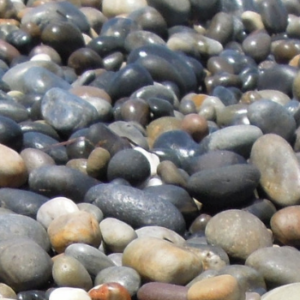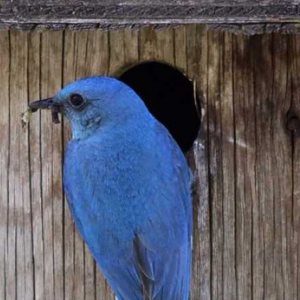IBA Local Action Fund
Nature Canada and Bird Studies Canada are injecting new energy into the Important Bird and Biodiversity (IBA) program. Over the past 20 years, millions of dollars and tens of thousands of hours of volunteer hours have been invested in protecting birds at Canada’s IBAs. We are committed to keeping Canada’s IBAs as a centrepiece of our site-related bird conservation work.
From 2008 to 2014, Nature Canada and in some cases First Nation partners, aimed to get an ‘on-the-ground” stewardship and advocacy presence in IBAs from local groups and individuals. Over this entire period, Nature Canada and BSC have worked hard to protect Canada’s IBAs through outreach, advocacy with governments and industry, and mobilization of citizen scientists to monitor IBAs.
A year into the new phase of IBA conservation work: the IBA Local Action Fund has worked to protect and conserve birds from coast to coast, including three in Nova Scotia, one in New Brunswick, one in PEI, one in Newfoundland-Labrador, three in Quebec, two in Manitoba and two in British Columbia. Thanks to the support of thousands of donors—Nature Canada and Bird Studies Canada are working with local groups on specific projects to protect, restore and enhance biodiversity and ecosystem integrity. Here are a few features on how we are putting your membership to work protecting Canada’s birds!
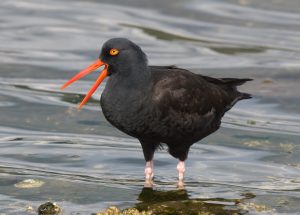
Black Oystercatchers
Laskeek Bay IBA, Charlotte BC
Project: Fostering local champions to protect seabirds
Summary:
The Laskeek Bay Conservation Society has worked with local individuals to monitor and manage invasive predator species, namely racoons and rats, that are threatening breeding birds in the Laskeek Bay IBA. The Laskeek Bay IBA is a nationally significant breeding site for a multitude of seabird species, including Ancient Murrelets, Pigeon Guillemots, Black Oystercatchers, and Glaucous-winged Gulls. The Laskeek Bay Conservation Society will continue to develop environmental stewards and enhance local capacity to understand and support this IBA.
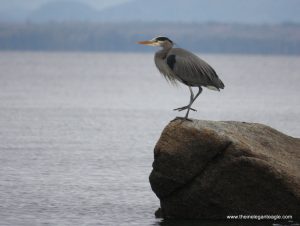
Great Blue Heron by Jim Dubois
K’ómoks IBA on the Coast of British Colombia
Project: Working with First Nations Guardian Watchmen on the K’omoks IBA.
Summary:
BC Nature has worked with First Nations Guardian Watchmen, who monitor & protect lands & waters on First Nations’ territories along the Vancouver Island coast. The partnership has worked to identify shared bird conservation issues and lay the groundwork to integrate bird monitoring into current Guardian Watchmen stewardship programs. Both the K’omoks Guardian Watchmen and Haida Gwaii First Nations members have been engaged in this active stewardship program.
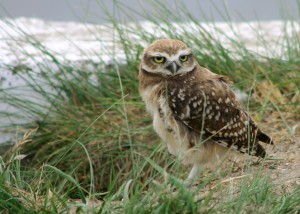
Burrowing Owl
Oak and Plum Lakes IBAs, Manitoba
Project: Cultivating local leadership to protect a mosaic of habitats and species.
Summary:
The Oak Lake and Plum Lakes IBAs provides a unique mosaic of habitats on the northeast periphery of the Northern Great Plains. Oak Lake is part of the Eastern Mixed-grass Prairie Regional Priority Area, an area prioritized for its high biodiversity value, high concentration of Species At Risk, and its unique ecological/biological landscapes. These diverse habitats are home to a number of species that need protection. Nature Manitoba has worked with indigenous groups and non-indigenous communities to establish a caretaker and stewardship network for this IBA.
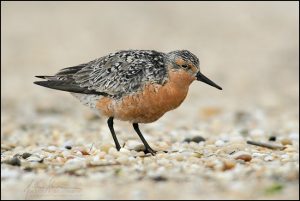
Red Knot
IBAs of Manitoba’s Hudson Bay lowlands: Seal River Estuary IBA, Churchill and Vicinity IBA, Nelson River Estuary and Marsh Point IBA, Kaskattama River Estuary IBA, Manitoba
Project: Monitoring Hudson Bay Coastal IBAs in Partnership with First Nations.
Summary:
Nature Manitoba has worked to engage local community members from Churchill and local First Nations in stewardship and monitoring on Hudson Bay coastal IBAs. The IBAs of Manitoba’s Hudson Bay lowlands are poorly known and susceptible to a range of threats from climate change to disturbance. This area is of high significance for many species including Buff-breasted Sandpiper, Pectoral Sandpiper, Black Scoter, Rusty Blackbird, Red Knot, Hudsonian Godwit and Cackling Goose. The IBA Program is now recognized by a number of people living and working around Churchill and has raised awareness of this area for High Arctic shorebirds.
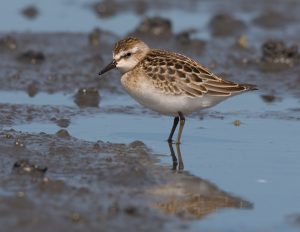
Semipalmated Sandpiper
Minas Basin IBA in Nova Scotia (Bay of Fundy)
Project: Developing a Safe Shorebird Roost Site in the Minas Basin IBA.
Summary:
The food-rich mudflats of the Minas Basin IBA support over 100,000 Semipalmated Sandpipers in addition to tens of thousands of other shorebirds during fall migration. Because of its very high ecological value as shorebird stopover site, the Minas Basin is designated as both an IBA of global significance (Semipalmated Sandpiper is the primary IBA trigger species) and a Western Hemisphere Shorebird Reserve Network (WHSRN) site of hemispheric importance.
A number of beaches are primary high tide roost sites used by shorebirds in the Minas Basin IBA. Intense summer recreational pressures, particularly striped bass fishing, coincide with peak fall migration in August. Through community events and outreach to local recreational users, businesses and tourism operators this project is will on its way to creating safe spaces for roosting shorebirds. Next steps the partners hope to build a volunteer program to support the continuation of these strategies in future years.

Roseate Tern
North Brother Island IBA, southwestern Nova Scotia, Universite Saine-Anne, Church Point, NS
Project: Collaborative effort to protect the Roseate Tern breeding colony in the gulf of Maine.
Summary:
This is a collaborative effort between stewards from Université Sainte-Anne and long-time North Brother Island IBA steward to protect the Roseate Tern population on North Brother Island through habitat assessment and enhancement activities and human impact mitigation. In order to protect the North Brother Island IBA, the Roseate Tern and other species of conservation interest, the group has worked to experiment with different management techniques to protect nesting Roseate Tern from predators and habitat degradation. 35 active volunteers supported this stewardship work over the past year, 12 of which are new to bird conservation stewardship!
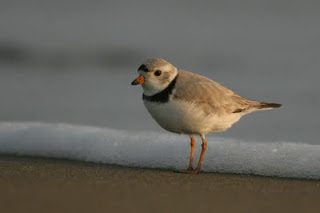
Piping Plover
Island Nature Trust IBA, PEI
Project: Collaborative effort to protect the Pipling Plovers in the Island Nature Trust IBA.
Summary:
Local groups worked to minimize human disturbance of tourism while educating visitors of the importance of the Island Nature Trust IBA and the Piping Plovers that breed there. The Island Nature Trust staff and volunteers developed conservation conscious training programs and educational materials to the community in order to protect the Piping Plovers. Building the capacity of local watershed groups and Mi’kmaq conservation groups will continue to build community awareness and support local decision-making that considers IBAs in the context of their ecological sensitivities.
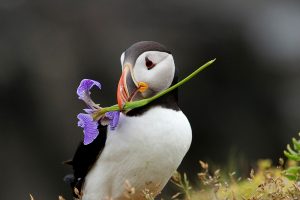
Atlantic Puffin by Chris MacDonald
Point Lepreau and Maces Bay IBAs surrounding the Bay of Fundy, NB
Project: Co-operative efforts to protect the Bay of Fundy from potential oil spills.
Summary:
The entire Bay of Fundy is of critical importance for the Atlantic Flyway, which migrating birds use in spring and fall as they travel between breeding and overwintering grounds. With existing shipping and industrial activity and the potential of increased oil tanker traffic from the Energy East project, there is real concern about the impact of potential oil spills on birds and marine life. As Energy East has demonstrated little interest in studying the impact of oil spills, Nature NB wishes to work with local partners to develop a strategy to increase awareness of the risks and impact of oil spills, encourage action at local IBAs and incite public insistence on protecting the environment upon which so many birds populations depend. The groups have worked on implementing adequate safety measures to protect migratory birds and their habitat.
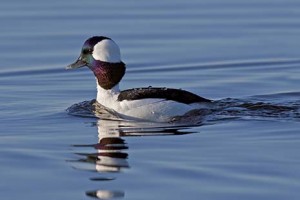
Bufflehead
Port L’Hebert and Port Joli harbours IBA, southwest shore Nova Scotia- Harrison Lewis Coastal Discovery Centre Society
Project: Building a public campaign to create a new marine protected area that would protect coastal IBAs in Nova Scotia.
Summary:
Nova Scotia local groups have worked to increase awareness in order to protect Port L’Hebert and Port Joli harbours IBA home to a number of species including Ipswich Sparrows, Piping Plovers, Green-Winged Teals, Norther Pintails, Common Goldeneyes, Buffleheads and more. By engaging local residents, fishers, the Mi’kmaq community, and local landowners, has worked with volunteers to work with Department of Fisheries and Oceans to protect the marine environment, bird life and biodiversity in these IBAs.

Semipalmated Sandpiper
Ile aux Basques et les Razades IBA. rois-Pistoles, Québec.
Project: Collaborative management action plans to protect Common Eiders on the Ile aux Basques et les Razades IBA.
Summary: The “Societe Provancher d’histoire naturelle du Canada” with the collaboration of some partners, including scientists from universities, volunteers and environmental organizations, undertook research to inform management actions to preserve nesting species on the island. They wanted to find the best method to manage Double-crested Cormorants in order to preserve a small population of breeding Common Eiders as well as some shorebirds. Their habitats are strongly impacted by the increase in cormorant populations. Volunteers made a mapping of the vegetation of the Razade Islands for students to analyze. The Societe Provancher will continue to invite volunteers from previous years to continue their involvement in the project.
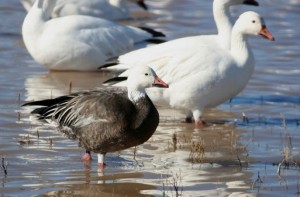
Photo from Flickr, Tony Battiste
Battures-de-Beauport IBA – Groupe d’éducation et d’écosurveillance de l’eau.
Project: Creating a community of concern for the Battures-de-Beauport IBA to protect Shorebirds.
Summary: The “Groupe d’éducation et d’écosurveillance de l’eau” (G3E) created an educational program about the Les Battures de Beauport IBA called“1, 2, 3 ZICO!” project. The IBA is in a very heavily populated area with many sources of disturbance including industry, shipping, pollution and significant recreational pressures. The area is known for its huge concentrations of Snow Geese and also as a stop-over for migrating shorebirds.1, 2, 3 ZICO (Zone Important pour la Conservation des Oiseaux – the French name for IBAs). The campaign was successful in raising awareness of the conservation issues affecting the IBA and the need for the development of solutions to protect the area among local residents and policymakers.
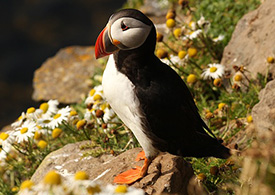
Atlantic Puffin
Witless Bay, Newfoundland Labrador
Project: Engage local community in workshops to reduce human threats to Atlantic Puffin colony.
Summary:
Canadian Parks and Wilderness Society Newfoundland-Labrador Chapter worked to protect the Atlantic Puffin colonies in the Witless Bay, IBA. For six years, CPAWS NL has worked within communities in close proximity of the Witless Bay Ecological Reserve to rescue and release puffins and petrels who become stranded on the mainland because of attraction to artificial lights. Light attraction from the local town is a source of mortality for young birds. The CPAWS local chapter has worked on a community solution to this problem so that young Atlantic Puffins and Leach’s Storm Petrels are not victims of local lights.
The project has worked to reduce human disturbance to nesting seabirds in the Witless Bay Ecological Reserve IBA; to increase knowledge and engagement among local citizens in the stewardship of the IBA; to increase awareness of the IBA and its conservation needs among the general public and visitors to the region.
Baie de Brador IBA, Ile aux Perroquets, Point Amour, and the Strait of Belle Isle IBA, Labrador: Quebec Labrador Foundation (QLF)
Project: This project has worked to improve local knowledge of the value of the Baie de Brador IBA, threats to its birds, and result in increased community engagement in IBA stewardship and support for the Migratory Bird and Sanctuary.
Summary:
Through meetings and workshops, the project worked to inform, guide, and motivate local leaders to reduce disturbance to the IBA and promote its ecological value. It worked to train youth to ID seabirds, prevent disturbance from boats, and conduct beach clean-ups.
Habitat degradation, climate change, pollution, and human impact pose grave threats to Important Bird Areas and Canadians need to band together to protect these critical habitats and wildlife. The IBA Action Fund was created to give much-needed funding to protect hundreds of species of birds across Canada – and now you can help too!
A gift today will be put to action to:
• Protect Habitat from several threats
• Save hundreds of species that call these IBAs home
• Help on the ground efforts to maintain and conserve IBAs for generations


